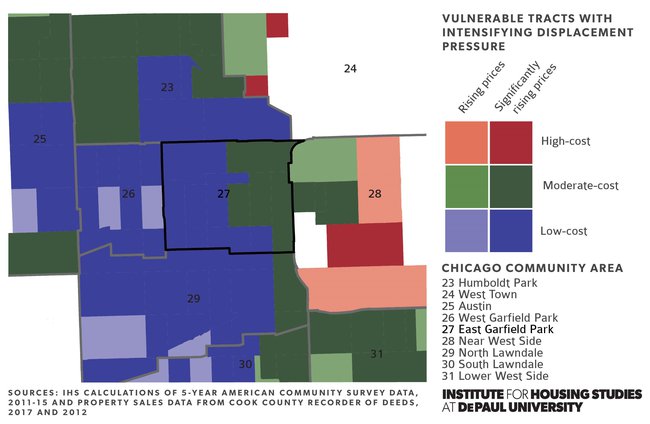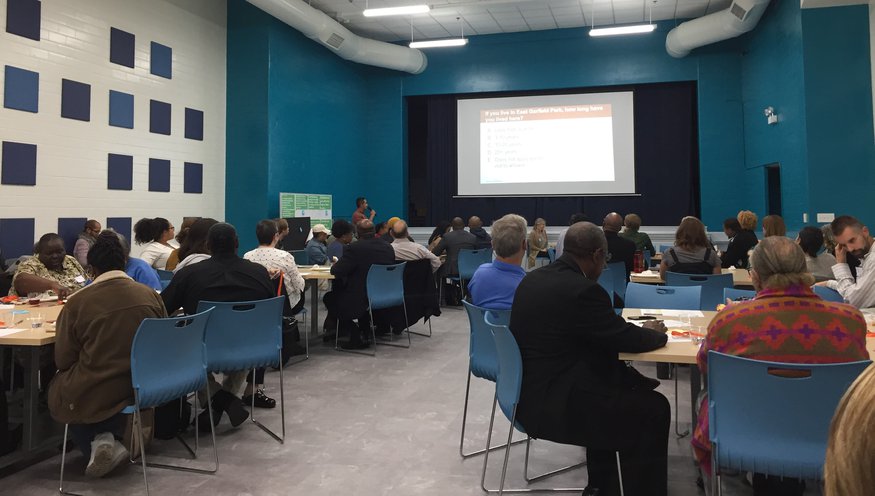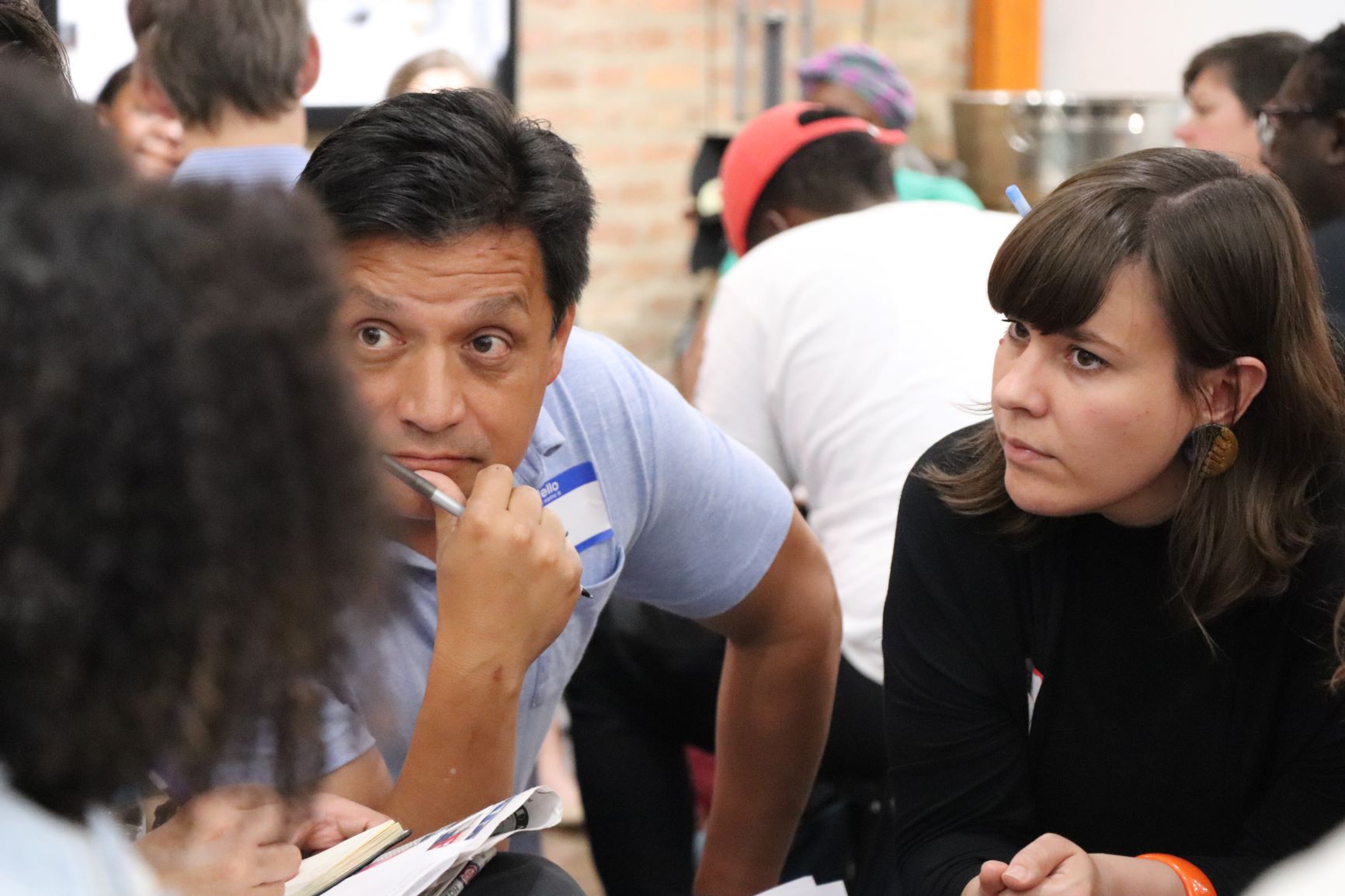Above: IHS Deputy Director, Sarah Duda (right), listens during a discussion at the first Preserving Affordability Together meeting. (Source: Metropolitan Planning Council)
A critical component of the Institute for Housing Studies’ (IHS) applied research model includes technical assistance to community groups and custom data analysis that illustrates different factors behind changing neighborhood dynamics. These types of data can provide a greater understanding of the reasons behind neighborhood change, provide evidence that amplifies the day-to-day experiences of community members, and inform community-led conversions to identify priorities and strategies.
We are starting a new blog series that highlights examples of IHS technical assistance projects. In this blog we describe a recent partnership IHS worked on in East Garfield Park.
Working Toward Proactive Anti-Displacement Strategies in East Garfield Park
How can communities anticipate and respond to new investment and work to ensure that it will benefit existing legacy residents? That is the question at the center of a community planning process led by IHS, the Metropolitan Planning Council (MPC), and Garfield Park Community Council (GPCC). In July, the Preserving Affordability Together pilot brought together residents, religious leaders, local businesses, and other neighborhood stakeholders for the first of a series of community meetings. The goal of the pilot is to support East Garfield Park community members in the development of a set of data-informed principals to guide anti-displacement policies and strategies.

Above: IHS Executive Director, Geoff Smith, presents IHS data to community members and stakeholders at the Preserving Affordability Together pilot meeting. (Source: Metropolitan Planning Council)
Before residents started brainstorming goals and strategies, IHS kicked off the community planning process by presenting research on economic, demographic, and housing market trends in East Garfield Park to highlight current conditions, emerging challenges, and opportunities for equitable development. IHS’s data analysis showcased early warning signs of growing housing affordability pressures such as rapid home price appreciation and investor demand for area properties. As the neighborhood’s housing market stabilizes after the foreclosure crisis, recent, rapid price appreciation paired with the vulnerability of many lower-income residents highlight the risk that increasing demand for housing in the area poses to current renters and homeowners. For example, residents, many who have lived and worked in East Garfield Park for their entire lives, voiced concerns about rising rents, the loss of unsubsidized affordable rental housing, and increased property taxes pricing them out of their community.
The data also showed that not all areas of East Garfield Park are experiencing displacement pressures in the same way. While some blocks see housing costs starting to rise to unaffordable levels, other lower-cost blocks face the legacy of long-term disinvestment, have a deteriorating housing stock in need of investment, and substantial numbers of publicly- and privately-owned vacant lots. The data illustrated that almost half of the housing supply in East Garfield Park is located in 2 to 4 unit buildings. These types of properties typically provide much of a neighborhood’s “naturally occurring” affordable housing, but are often the most vulnerable to rising rents in a rapidly appreciating market. Therefore, identifying strategies to preserve this stock as affordable are critical if nearby vacant land is redeveloped.

Figure 1: Displacement pressure and uneven market recovery in and around East Garfield Park
The dynamics affecting neighborhood change can be uneven and differentiated within a neighborhood. There can be geographic variation in market conditions within a neighborhood that may point to different types of anti-displacement strategies. There can also be variation in different types of residents in a community that may have different housing needs. The varied drivers of neighborhood change call for a multi-pronged approach.
With IHS’s data in mind, stakeholders convened for a second community meeting to collectively discuss opportunities for future action. Community members identified a set of housing priorities, including stabilizing current homeowners through property tax relief, aiding housing cost burdened renters by establishing affordable housing programs and pathways to homeownership, and passing policies that require broad community benefits from new investment. Community members emphasized the importance of input from local stakeholders before and during the development process, not after development has been built. From this community process, IHS, MPC, and GPCC created a fact sheet summarizing housing market trends and displacement pressures to guide future conversations and decision making in East Garfield Park. Residents, churches, nonprofits, and activists took the initial steps to form a coalition in order to strengthen African American leadership, work across various stakeholder interests, and continue similar community led processes to ensure development without displacement in East Garfield Park is more than just a slogan.

Above: Community members and stakeholders convene for the second time to discuss housing priorities and strategies for the creation of an action plan. (Source: Jessie Wang)
Data in Action
An important component of IHS’s applied research model includes building partnerships with community-based stakeholders. These partnerships connect IHS's technical expertise to local non-profits, bolstering their capacity to use data to inform their work. Partnerships also allow IHS to learn about the issues that communities are experiencing on the ground and gain a deeper understanding of changing housing market dynamics as they emerge. IHS’s role as a data intermediary in East Garfield Park illustrates how data analysis that is tailored to the neighborhood context can inform community-centered discussions about addressing different types of housing challenges facing Chicago’s neighborhoods.
Stay tuned for future examples.






